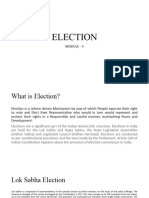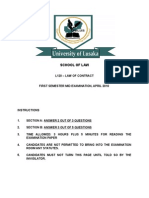0 ratings0% found this document useful (0 votes)
105 viewsNCST
NCST
Uploaded by
Gowdham PThe document discusses the National Commission for Scheduled Tribes (NCST) in India. Some key points:
1) NCST is a constitutional body established in 2004 to specifically address issues facing Scheduled Tribes, as they were previously grouped with Scheduled Castes under one commission.
2) It consists of a chairperson, vice chairperson and three full-time members, including one female member.
3) The NCST's functions include investigating matters regarding ST safeguards, evaluating development programs for STs, and advising the central and state governments on welfare, protection and development of STs.
4) As of 2016, Nand Kumar Sai is the chairperson of
Copyright:
© All Rights Reserved
Available Formats
Download as PDF, TXT or read online from Scribd
NCST
NCST
Uploaded by
Gowdham P0 ratings0% found this document useful (0 votes)
105 views3 pagesThe document discusses the National Commission for Scheduled Tribes (NCST) in India. Some key points:
1) NCST is a constitutional body established in 2004 to specifically address issues facing Scheduled Tribes, as they were previously grouped with Scheduled Castes under one commission.
2) It consists of a chairperson, vice chairperson and three full-time members, including one female member.
3) The NCST's functions include investigating matters regarding ST safeguards, evaluating development programs for STs, and advising the central and state governments on welfare, protection and development of STs.
4) As of 2016, Nand Kumar Sai is the chairperson of
Original Description:
NCST
Copyright
© © All Rights Reserved
Available Formats
PDF, TXT or read online from Scribd
Share this document
Did you find this document useful?
Is this content inappropriate?
The document discusses the National Commission for Scheduled Tribes (NCST) in India. Some key points:
1) NCST is a constitutional body established in 2004 to specifically address issues facing Scheduled Tribes, as they were previously grouped with Scheduled Castes under one commission.
2) It consists of a chairperson, vice chairperson and three full-time members, including one female member.
3) The NCST's functions include investigating matters regarding ST safeguards, evaluating development programs for STs, and advising the central and state governments on welfare, protection and development of STs.
4) As of 2016, Nand Kumar Sai is the chairperson of
Copyright:
© All Rights Reserved
Available Formats
Download as PDF, TXT or read online from Scribd
Download as pdf or txt
0 ratings0% found this document useful (0 votes)
105 views3 pagesNCST
NCST
Uploaded by
Gowdham PThe document discusses the National Commission for Scheduled Tribes (NCST) in India. Some key points:
1) NCST is a constitutional body established in 2004 to specifically address issues facing Scheduled Tribes, as they were previously grouped with Scheduled Castes under one commission.
2) It consists of a chairperson, vice chairperson and three full-time members, including one female member.
3) The NCST's functions include investigating matters regarding ST safeguards, evaluating development programs for STs, and advising the central and state governments on welfare, protection and development of STs.
4) As of 2016, Nand Kumar Sai is the chairperson of
Copyright:
© All Rights Reserved
Available Formats
Download as PDF, TXT or read online from Scribd
Download as pdf or txt
You are on page 1of 3
UPSC Civil Services Examination
Political Science & International Relations
Topic: - NCST- National Commission for Scheduled Tribes - Indian
Polity Notes
National Commission for Scheduled Tribes (NCST)
The Constitution of India does not give any definition for Scheduled Tribes. According to Article 366(25) of the
Constitution, Scheduled Tribes are those communities who are scheduled in accordance with Article 342 of the
Constitution. Also, Article 342 of the Constitution says that: The Scheduled Tribes are the tribes or tribal
communities or part of or groups within these tribes and tribal communities which have been declared as such by
the President through a public notification.
Scheduled Tribes in India
According to the 2011 Census, the Scheduled Tribes account for 104 million representing 8.6% of the country’s
population. These Scheduled Tribes are spread throughout the country largely in forest and hilly regions.
The essential characteristics of these communities are:-
o Primitive Traits
o Geographical isolation
o Distinct culture
o Shy of contact with community at large
o Economically backwards
As in the case of the SCs, the Plan objective of empowering the tribals is being achieved through a three-
pronged strategy of social empowerment, economic empowerment and social justice.
National Commission for Scheduled Tribes (NCST)
The National Commission for Scheduled Tribes is a constitutional body that was established by the Constitution
(89th Amendment) Act, 2003.
Earlier, there was only one commission, which was for both the scheduled tribes and scheduled castes. In
2004, after the 89th Constitutional Amendment Act, the NCST was established by bifurcating the
National Commission for Scheduled Castes and Scheduled Tribes into the NCST and the National
Commission for Scheduled Castes.
This amendment replaced the National Commission for Scheduled Castes and Scheduled Tribes with two
distinct commissions which are:
o National Commission for Scheduled Castes (NCSC)
o National Commission for Scheduled Tribes (NCST)
Composition of NCST
The NCST consists of one chairperson, one vice chairperson and three full-time members. Out of the three
members, there should compulsorily be one lady member. All the members of the Commission has a tenure of 3
years.
Functions of National Commission for Scheduled Tribes
NCST investigates and monitors all matters related to safeguarding the provisions for Scheduled Tribes
under the Constitution and evaluating the working of those safeguards.
NCST will inquire into specific complaints concerned with the deprivation of rights and safeguards of the
STs.
The commission participates and advises on the planning process for the socio-economic development of
the STs and also evaluates the progress of the various developmental activities.
The President will be presented with an annual report of the working of those safeguards. Apart from
annual reports, other reports also will be submitted to the President as and when necessary.
The Commission will also give reports on what measures are to be taken by both the central and various
state governments for an effective execution of the measures and safeguards for the protection,
development and welfare of the STs.
Other functions of NCST are related to welfare, protection, development & advancement of the STs.
UPSC Questions related to Scheduled Tribes and NCST
Who is the present chairman of National Commission for Scheduled Tribes?
Urmila Singh was appointed as the Chairperson during the second commission of 2007. The third
Commission was constituted in 2010 with Rameshwar Oraon as the Chairperson.
At the age of 71, Nand Kumar Sai, became the successor of Rameshwar after his tenure ended in 2016.
Nand Kumar Sai is a senior tribal leader and an ex-parliamentarian from Chhattisgarh.
Who appoints SC & ST Commission?
The President of India appoints them.
You might also like
- Lititiz Watch Technicum Application For AdmissionDocument6 pagesLititiz Watch Technicum Application For AdmissionmemorylapsepressNo ratings yet
- Qatar EmploymentDocument7 pagesQatar EmploymentMohammad Tarique67% (3)
- National Commissions - SC, ST & OBC - 2Document3 pagesNational Commissions - SC, ST & OBC - 2Govind TripathiNo ratings yet
- National Commission For SCDocument14 pagesNational Commission For SCAhmad Fawad FerdowsNo ratings yet
- Difference Between Scheduled Caste and Scheduled TribeDocument4 pagesDifference Between Scheduled Caste and Scheduled Tribeziaftulislam016No ratings yet
- Recomendations of XAXA CommitteeDocument24 pagesRecomendations of XAXA CommitteePrajwal K.M.No ratings yet
- National Commission For Backward ClassesDocument6 pagesNational Commission For Backward ClassesDr Rakesh ThakorNo ratings yet
- Ladakh Under Sixth ScheduleDocument3 pagesLadakh Under Sixth Schedulezeenak26110No ratings yet
- Assignment On Government BodiesDocument3 pagesAssignment On Government Bodiesgokuvegetadbz04No ratings yet
- Tribes in India & Related ProvisionsDocument15 pagesTribes in India & Related Provisionssaurabh bhardwaj100% (1)
- Human Rights, Violation and Redressal Mechanism of SC & STDocument15 pagesHuman Rights, Violation and Redressal Mechanism of SC & STHRM-9506 Siddhi ChavanNo ratings yet
- Constitutional Safeguards For SCDocument11 pagesConstitutional Safeguards For SCJYOTI JYOTINo ratings yet
- Constitutional Status For National Commission For Backward ClassesDocument3 pagesConstitutional Status For National Commission For Backward Classesgitalel223No ratings yet
- Constitutional Provisions For SCDocument3 pagesConstitutional Provisions For SCGaurav PrabhakerNo ratings yet
- Utkarsh Kumar - Role and Effect of Central and State Government Scheme in Welfare of Tribal Communities in India - Article 2 - Batch 1Document10 pagesUtkarsh Kumar - Role and Effect of Central and State Government Scheme in Welfare of Tribal Communities in India - Article 2 - Batch 1Utkarsh KumarNo ratings yet
- National Commission For Scheduled Tribes NCST Formation Objectives Powers Etc For Upsc 95519f31Document5 pagesNational Commission For Scheduled Tribes NCST Formation Objectives Powers Etc For Upsc 95519f31debasish swainNo ratings yet
- Constitutional ProvisionsDocument27 pagesConstitutional Provisionssanyamana935No ratings yet
- NHRCDocument7 pagesNHRCSuryansh GargNo ratings yet
- Summary Sheet - Social JusticeDocument30 pagesSummary Sheet - Social JusticevenshmasuslaNo ratings yet
- Yojana July Summary Policies On Scheduled Tribes Explained PointwiseDocument5 pagesYojana July Summary Policies On Scheduled Tribes Explained Pointwiseଖପର ପଦା ଜନତାNo ratings yet
- Panchayati Raj in TripuraDocument5 pagesPanchayati Raj in Tripuramobarakhossain661No ratings yet
- Answers 17Document35 pagesAnswers 17Janvi GuptaNo ratings yet
- Unit - VDocument19 pagesUnit - Vhello.mythosNo ratings yet
- Law 4101 Constitutional LawDocument16 pagesLaw 4101 Constitutional LawSai Aik Hseng MongNo ratings yet
- Important Tribes of India - UPSCDocument17 pagesImportant Tribes of India - UPSCRishu kumarNo ratings yet
- Independent BodiesDocument1 pageIndependent BodiesMandar DeshmukhNo ratings yet
- National Commission For Scheduled Tribes: Why in News?Document3 pagesNational Commission For Scheduled Tribes: Why in News?gitalel223No ratings yet
- SC/ST Quota ExtensionDocument4 pagesSC/ST Quota ExtensionNishantNo ratings yet
- Article 338 B-Protection and Safeguards To Other Backward Classes A.GeneralDocument4 pagesArticle 338 B-Protection and Safeguards To Other Backward Classes A.GeneralMano EzhilmaniNo ratings yet
- National Human Rights Commission NHRCDocument7 pagesNational Human Rights Commission NHRCchristinaa.110915No ratings yet
- INSIGHTS DAILY CURRENT AFFAIRS PIB SUMMARY - 6 August 2021Document11 pagesINSIGHTS DAILY CURRENT AFFAIRS PIB SUMMARY - 6 August 2021Heavy DriverNo ratings yet
- Role of NCM State, SC/ST CommissionDocument29 pagesRole of NCM State, SC/ST Commissionsaransh yadavNo ratings yet
- Hsslive-Plus 1 Political Science Focus Area EnglishDocument10 pagesHsslive-Plus 1 Political Science Focus Area EnglishPes 2021No ratings yet
- Anthro InterviewDocument34 pagesAnthro InterviewChinmay JenaNo ratings yet
- different protection given to backward classesDocument7 pagesdifferent protection given to backward classesmanaliphilo1989No ratings yet
- Ic 3rdsemDocument10 pagesIc 3rdsempratiklaheri9No ratings yet
- Chapter-I I: NtroductionDocument42 pagesChapter-I I: NtroductionKavya MNo ratings yet
- 1047834Document11 pages10478342s2bychknkNo ratings yet
- 2018 PolDocument16 pages2018 Polnitin pandeyNo ratings yet
- Constitutional Bodies in India: by - Indo Pathshala Contact Number - 9123206137Document5 pagesConstitutional Bodies in India: by - Indo Pathshala Contact Number - 9123206137surya kantNo ratings yet
- Reserved Category Legislations and Schemes Are Designed To Promote SocialDocument2 pagesReserved Category Legislations and Schemes Are Designed To Promote SocialSharulNo ratings yet
- Worksheet For Practice: HistoryDocument2 pagesWorksheet For Practice: HistorypareekujwalNo ratings yet
- Civil RightsDocument34 pagesCivil RightsMohit pathakNo ratings yet
- Role of Election Commision in IndiaDocument17 pagesRole of Election Commision in IndiaVideh VaishNo ratings yet
- Anthroguru Reports SummariesDocument95 pagesAnthroguru Reports SummariesRishi KasrijaNo ratings yet
- China, Cuba, Russia and NKDocument73 pagesChina, Cuba, Russia and NKyetyetNo ratings yet
- Background of Caste Based ReservationDocument14 pagesBackground of Caste Based ReservationSaiby KhanNo ratings yet
- National Human Rights Commission Upsc Notes 17Document5 pagesNational Human Rights Commission Upsc Notes 17ved prakash raoNo ratings yet
- Social Justice-5Document13 pagesSocial Justice-5Aditya KumarNo ratings yet
- A Critical Study of Mandal CommissionDocument4 pagesA Critical Study of Mandal CommissionAmit KumarNo ratings yet
- The Sixth Schedule of The Indian Constitution With SpecialDocument9 pagesThe Sixth Schedule of The Indian Constitution With SpecialExtreme TronersNo ratings yet
- NationalDocument2 pagesNationalApple MudasirNo ratings yet
- Constitutional Bodies in India Upsc Notes 921684870743934Document7 pagesConstitutional Bodies in India Upsc Notes 921684870743934ashu kandalaNo ratings yet
- Reservation Policy PPMDocument74 pagesReservation Policy PPMIndian Railways Knowledge PortalNo ratings yet
- ReservationDocument14 pagesReservationLakshanmayaNo ratings yet
- M-5 ElectionDocument23 pagesM-5 ElectionLibarat PwmrwiNo ratings yet
- 5 6055386678808282402Document19 pages5 6055386678808282402Yogendra SolankiNo ratings yet
- An Interface Between Sixth Schedule and Tribal AutonomyDocument19 pagesAn Interface Between Sixth Schedule and Tribal AutonomyExtreme TronersNo ratings yet
- Civil Services in IndiaDocument34 pagesCivil Services in IndiaAbhinav GuptaNo ratings yet
- Autonomous District Councils and Panchayati Raj Insitutions in NorthDocument11 pagesAutonomous District Councils and Panchayati Raj Insitutions in NorthKshitij Ramesh DeshpandeNo ratings yet
- It’s Time to Implement the Forgotten Constitution of India for Liberty and DignityFrom EverandIt’s Time to Implement the Forgotten Constitution of India for Liberty and DignityRating: 3 out of 5 stars3/5 (2)
- INTERLINK MOVIE HOUSES, INC. Vs COURT OF APPEALSDocument3 pagesINTERLINK MOVIE HOUSES, INC. Vs COURT OF APPEALSBryanNavarroNo ratings yet
- ABJJFComp Registration FormDocument1 pageABJJFComp Registration FormgbarkansasNo ratings yet
- Windy A. Malapit: Oblicon Case DigestDocument10 pagesWindy A. Malapit: Oblicon Case DigestWindy Awe MalapitNo ratings yet
- 183finance For Housing Schemes Ucbs1Document3 pages183finance For Housing Schemes Ucbs1SUMIT SINHANo ratings yet
- UCC PartsDocument2 pagesUCC PartsJudicial_Fraud100% (1)
- Leave and Licence AgreementDocument12 pagesLeave and Licence AgreementpropertyworldlinksNo ratings yet
- Salt Lake City and Utah Inland Port Authority ContractDocument24 pagesSalt Lake City and Utah Inland Port Authority ContractThe Salt Lake TribuneNo ratings yet
- Qatar Labor LawDocument31 pagesQatar Labor LawVivekanand80% (5)
- Peoria County Booking Sheet 10/11/15Document7 pagesPeoria County Booking Sheet 10/11/15Journal Star police documentsNo ratings yet
- Global Derivatives Debacles From Theory To Malpractice PART I FORWARDS - BookDocument34 pagesGlobal Derivatives Debacles From Theory To Malpractice PART I FORWARDS - BookEma LjubenovićNo ratings yet
- Disc Conf Req FormDocument3 pagesDisc Conf Req FormpapercrunchNo ratings yet
- Macasiano V DioknoDocument2 pagesMacasiano V DioknoErika ColladoNo ratings yet
- PossessionDocument17 pagesPossessionIMRAN ALAMNo ratings yet
- DRUGPDocument371 pagesDRUGPPolarogramaNo ratings yet
- Joseph Vs The State of KeralaDocument14 pagesJoseph Vs The State of KeralaAashish KohliNo ratings yet
- A.C. No. 10164Document2 pagesA.C. No. 10164Rose Ann VeloriaNo ratings yet
- Current Account Application Form For Non-UK EU ResidentsDocument11 pagesCurrent Account Application Form For Non-UK EU ResidentsarayNo ratings yet
- JAT Wheels v. DB Motoring - Tentative RulingDocument8 pagesJAT Wheels v. DB Motoring - Tentative RulingSarah BursteinNo ratings yet
- Ajenor Hotel Service ContractDocument5 pagesAjenor Hotel Service ContractOlexei SmartNo ratings yet
- Gil v. Murciano (Flores)Document2 pagesGil v. Murciano (Flores)Ruther FloresNo ratings yet
- The Solicitor General For Petitioner. Eribert D. Ignacio For Respondents David Cruz, Socorro Concio Cruz and Lorna CruzDocument22 pagesThe Solicitor General For Petitioner. Eribert D. Ignacio For Respondents David Cruz, Socorro Concio Cruz and Lorna CruzKriska Herrero TumamakNo ratings yet
- DLSU 2019 - Legal and Judicial Ethics - Green Notes PDFDocument72 pagesDLSU 2019 - Legal and Judicial Ethics - Green Notes PDFJaymee Andomang Os-ag100% (1)
- SK Funds Utilization 2018Document38 pagesSK Funds Utilization 2018Sheila Marie MaeNo ratings yet
- Al Rushaid V Bradnam Judgement FinalDocument24 pagesAl Rushaid V Bradnam Judgement FinalLfshriyadhNo ratings yet
- Procedure For Obtaining LicenseDocument8 pagesProcedure For Obtaining LicenseAslam SiddiqNo ratings yet
- De La Cerna Vs Potot 120 Phil 1361 12 SCRA 576Document2 pagesDe La Cerna Vs Potot 120 Phil 1361 12 SCRA 576andrea ibanezNo ratings yet
- Bus Ticket: Passengers DetailsDocument2 pagesBus Ticket: Passengers Detailsnaveen deswal BONGAIGAONNo ratings yet
- Contract Law Mid Exam April 2010Document5 pagesContract Law Mid Exam April 2010Mwiza MhangoNo ratings yet

























































































